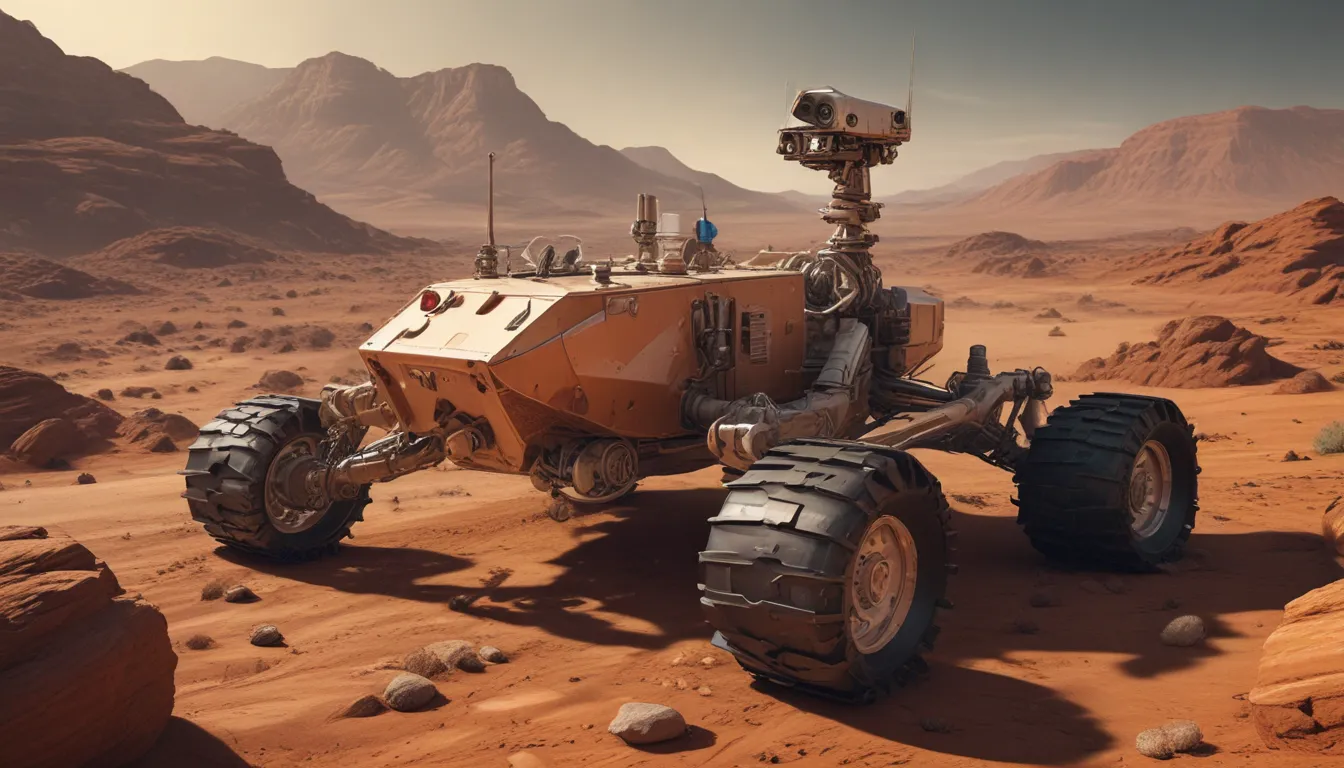The pictures we use in our articles might not show exactly what the words say. We choose these pictures to make you interested in reading more. The pictures work together with the words but don’t take their place. The words still tell you the important facts.
Mars, the enigmatic fourth planet from the Sun, has captivated the curiosity of scientists and space enthusiasts alike for decades. With numerous missions sent to unravel its mysteries, one of the most groundbreaking contributions has come from the innovative Mars rovers. These remarkable robotic explorers have reshaped our understanding of Mars by collecting valuable data, uncovering astonishing discoveries, and pushing the boundaries of space exploration.
Delving into the World of Mars Rovers
Let's embark on a journey through the realm of Mars rovers and uncover 20 mind-blowing facts that will leave you in awe of these extraordinary machines. From their remarkable engineering feats to their exceptional endurance, these rovers have been instrumental in our quest to decode the secrets of Mars. So, fasten your seatbelts and get ready for a voyage of discovery as we unveil the captivating world of Mars rovers.
Key Takeaways
- Mars rovers have been exploring the red planet since 1997, unveiling evidence of water, diverse rock formations, and sparking public fascination with the quest for extraterrestrial life.
- The future of Mars exploration holds promise with advanced rovers like NASA’s Perseverance and the European Space Agency’s ExoMars poised to continue expanding scientific frontiers on Mars.
Unveiling the Realm of Mars Rovers
Since the pioneering landing of the Pathfinder mission’s Sojourner rover in 1997, Mars has witnessed a continuous presence of robotic rovers, enriching our knowledge of its geology and climate.
The Starring Role of Curiosity
Curiosity, also known as the Mars Science Laboratory, stands out as the most renowned Mars rover to date. Launched in 2011, it remains operational, providing vital data and images from the red planet.
Roaming the Martian Terrain: Opportunity’s Record-Breaking Journey
Opportunity, a robotic geologist, holds the impressive record for covering over 28 miles (45 kilometers) during its mission on Mars, surpassing past accomplishments on the Moon.
Powering Up with Solar Energy
Mars rovers rely on solar panels to generate electricity for their scientific instruments, mobility, and communication systems. These panels are strategically designed to maximize energy production in Mars' dusty atmosphere.
An Arsenal of Scientific Instruments
Equipped with an array of tools including cameras, spectrometers, drills, and weather sensors, each Mars rover boasts a unique set of scientific instruments tailored to its mission objectives.
Unlocking Mars’ Watery Secrets
Several rovers, including Curiosity, Spirit, and Opportunity, have unveiled indications of past water activity on Mars. These findings bolster the intriguing possibility of ancient life on Mars.
Exceeding Expectations: The Triumph of Spirit and Opportunity
Originally slated for a 90-day mission, the twin rovers Spirit and Opportunity defied expectations, operating on Mars for over 6 and 14 years, respectively.
Building Bridges with Orbiting Satellites
Given the vast Mars-Earth distance, the rovers rely on orbiting satellites like the Mars Reconnaissance Orbiter to relay data, images, and commands between the two planets.
Touching Down: Unique Landing Approaches
From airbags and skycranes to retro-rockets, each Mars rover employs a distinct landing system tailored to mission requirements and the planet's challenging atmosphere.
Enduring Mars’ Harsh Climate
With frigid temperatures plummeting to -80 degrees Fahrenheit (-62 degrees Celsius) on average, Mars rovers are equipped with specialized insulation and heating systems to withstand the extreme conditions.
Capturing Martian Beauty: Panoramic Views
Armed with high-resolution cameras, the rovers have delivered breathtaking panoramic images of Mars’ landscapes, offering a glimpse into the planet’s captivating beauty.
Unveiling Mars’ Geological Tapestry
Through rock sample analysis, soil studies, and geological examinations, the rovers have shed light on Mars' history, laying the groundwork for understanding its potential for harboring life.
Wheels of Progress: Navigating Martian Terrain
Featuring intricate designs for optimal traction and durability, the rovers' wheels are crafted to navigate Mars' rugged landscape, conquering obstacles as tall as the wheels themselves.
Autonomous Exploration: Charting their Course
Empowered with advanced software, the rovers autonomously navigate Mars, analyzing terrain, evading obstacles, and planning their routes with minimal intervention from mission control.
Unveiling the Secrets of Martian Soil
Through drilling and soil analysis, the rovers have unveiled invaluable data about Mars’ soil composition, aiding in deciphering its potential for microbial life and future human exploration.
Conquering Dust Storms: Overcoming Challenges
Amidst severe dust storms on Mars, the rovers have persevered, surmounting visibility and energy production hurdles to continue their scientific pursuits.
Tracing Martian History: Rock Formations Revealed
By studying diverse rock formations, the rovers have unearthed evidence of volcanic activity, sedimentary layers, and ancient water erosion, providing crucial insights into Mars' geological evolution.
Inspiring Wonder: Capturing Public Imagination
With their groundbreaking accomplishments and captivating imagery, Mars rovers have sparked fascination worldwide, inspiring future generations of scientists and garnering public support for space exploration endeavors.
Pioneering the Search for Extraterrestrial Life
By delving into Mars' habitability and hunting for biosignatures, the rovers have played a pivotal role in the ongoing pursuit of detecting life beyond Earth.
Embracing Advancements: A Promising Future
With upcoming missions like NASA’s Perseverance rover and the European Space Agency’s ExoMars rover, the future of Mars exploration shines bright, promising to expand the horizons of scientific discovery on the enigmatic red planet.
With these 20 captivating facts about Mars rovers, we gain a profound appreciation for their extraordinary contributions in unraveling the mysteries of Mars. From tracing ancient waterways to enhancing our grasp of Mars' geological past, these robotic pioneers have forever altered our perceptions of the neighboring planet. As we anticipate the next chapter in Mars exploration, we eagerly await the groundbreaking revelations that lie ahead.
In Closing
In conclusion, Mars rovers have redefined our understanding of the red planet, offering invaluable insights into Mars' geology, climate, and potential for life. The 20 remarkable facts we've uncovered underscore the remarkable achievements of these rovers, from unprecedented distance travels to the discovery of age-old riverbeds.
As we eagerly anticipate future Mars missions, we acknowledge the monumental strides made by Curiosity, Spirit, Opportunity, and their successors in paving the way for further exploration. Their legacies endure as a testament to human ingenuity and our unwavering commitment to unveiling the mysteries of the cosmos.
FAQs
Q: How many Mars rovers have explored the red planet?
A: Four Mars rovers have ventured to Mars: Sojourner, Spirit, Opportunity, and Curiosity.
Q: How long does it take for a Mars rover to reach Mars?
A: The travel duration for a Mars rover to reach Mars can vary, typically spanning between six to nine months.
Q: What is the primary objective of Mars rovers?
A: Mars rovers are designed to explore the Martian surface, gather data, and seek signs of past or present life.
Q: How do Mars rovers transmit data back to Earth?
A: Mars rovers relay data to Earth through a combination of orbiters acting as relays and direct communication using antennas.
Q: What is the average operational lifespan of Mars rovers on the Martian surface?
A: Mars rovers are engineered for specific mission durations, ranging from several months to many years. For instance, the Opportunity rover exceeded its planned 90-day mission, operating for over 14 years.
In the enchanting realm of space exploration, the Mars rovers stand as beacons of human achievement and curiosity. As we unravel the mysteries of Mars and contemplate the vast expanse of the universe, the legacy of these robotic pioneers continues to inspire awe and wonder. Let us venture forward with a shared sense of wonderment and a steadfast dedication to uncovering the secrets of cosmos—one discovery at a time.






